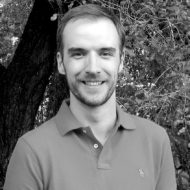About
Extreme environments are a frontier for discovery – the intense heat of thermal vents in the ocean, the frigid vacuum of space, the crushing pressures at the center of the earth.
Brad Ramshaw and his team use extreme magnetic fields – thousands of times stronger than the magnets on your fridge – to manipulate and harness quantum mechanics. For example, they study high-temperature superconductors, which are metals with no electrical resistance below a certain temperature. Having zero electrical resistance makes these materials very attractive for distributing power and for creating quantum circuits, but it also makes it hard to measure many of their properties—properties Ramshaw and his team want to know so that they can engineer a superconductor that works at room temperature. To overcome this challenge, they perform their experiments in extremely strong magnetic fields, up to 100 tesla, that “turn off” the zero-resistance property. This allows them to see what the superconductor would be doing if it wasn’t a superconductor, kind of like turning off a motor so you can take it apart to see how it works. They used this to discover that high-temperature superconductors are extremely strange when you get rid of the superconductivity – the electrons that carry the electrical current drag each other around in a way you don’t see in a regular metal. This tendency for electrons to influence each other—i.e. “strongly correlated” behaviour—appears to be what causes these materials to be such good superconductors when the magnetic field is turned off.
Awards
- Sloan Fellowship, Sloan Foundation, 2019.
- Kavli Fellow, Kavli Foundation, 2018.
- Lee Osheroff Richardson Science Prize, Oxford Instruments, 2017.
- Director’s Fellow, Los Alamos National Labs, 2013.
- Martin and Beate Block Physics Award, Aspen Center For Physics, 2011.
Relevant Publications
- Yawen Fang, Gael Grissonnanche, Anaelle Legros, Simon Verret, Francis Laliberte, Clement Collignon, Amirreza Ataei, Maxime Dion, Jianshi Zhou, David Graf, M. J. Lawler, Paul Goddard, Louis Taillefer, and B. J. Ramshaw. Fermi surface transformation at the pseudogap critical point of a cuprate superconductor. Nature Physics, pages 1–7, 2022.
- Gaël Grissonnanche, Yawen Fang, Anaëlle Legros, Simon Verret, Francis Laliberté, Clément Collignon, Jianshi Zhou, David Graf, Paul A Goddard, Louis Taillefer, and B. J. Ramshaw. Linear-in temperature resistivity from an isotropic Planckian scattering rate. Nature, 595(7869):667–672, 2021.
- Sayak Ghosh, Arkady Shekhter, F Jerzembeck, N Kikugawa, Dmitry A Sokolov, Manuel Brando, AP Mackenzie, Clifford W Hicks, and B. J. Ramshaw. Thermodynamic Evidence for a Two-Component Superconducting Order Parameter in Sr2RuO4. Nature Physics, 17(2):199–204, 2021.
S. Ghosh, A. Shekhter, F. Jerzembeck, N. Kikugawa, D. A. Sokolov, M. Brando, A. P. Mackenzie, C. W. Hicks, and B. J. Ramshaw. Thermodynamic evidence for a two-component superconducting order parameter in Sr2RuO4. To appear in Nature Physics, 2020
Y. Fang, G. Grissonnanche, A. Legros, S. Verret, F. Laliberte, C. Collignon, A. Ataei, M. Dion, J. Zhou, D. Graf, M. J. Lawler, P. Goddard, L. Taillefer, and B. J. Ramshaw. Fermi surface transformation at the pseudogap critical point of a cuprate superconductor. Preprint at arXiv:2004.01725, 2020
S. Ghosh, M. Matty, R. Baumbach, E. D. Bauer, K. A. Modic, A. Shekhter, J. A. Mydosh, E. Kim, and B. J. Ramshaw. One-component order parameter in URu2Si2 uncovered by resonant ultrasound spectroscopy and machine learning. Science Advances, 6(10):eaaz4074, 2020
